
- News
- Basics
- Products
- JP Job shop
- Exhibition
- Interview
- Statistic
- PR
- Download
- Special contents
Basics
April 8, 2022
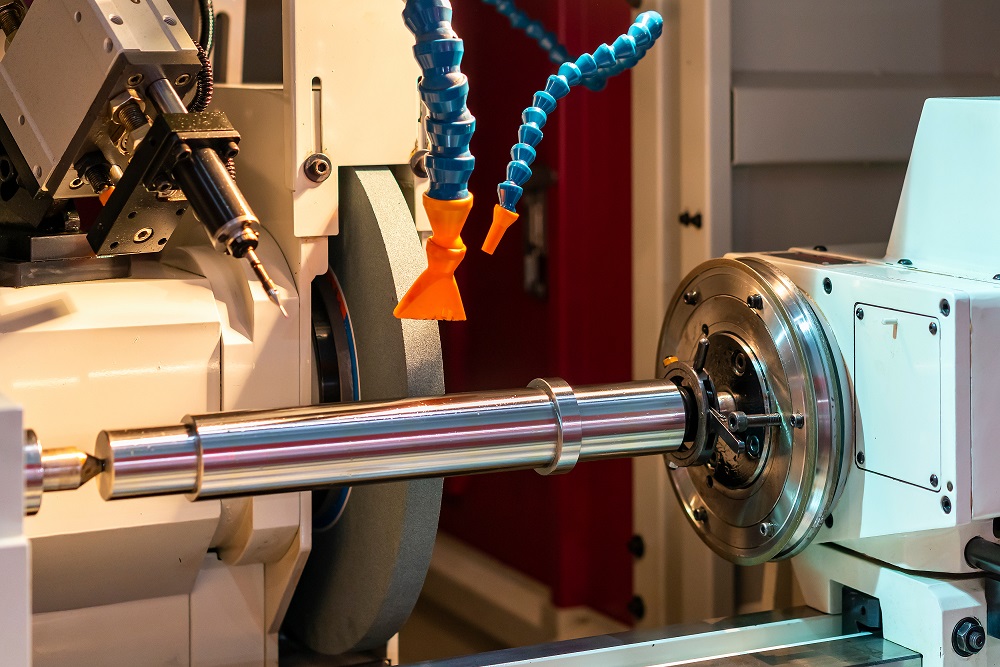
Contents:
1. What is a grinding machine?
2-1. External cylindrical grinding machine
2-2. Internal cylindrical grinding machine
2-3. Centerless grinding machine
2-4. Surface grinding machines
2-7. Gear-, Thread- and Jig grinding machine
2-8. Grinding centers
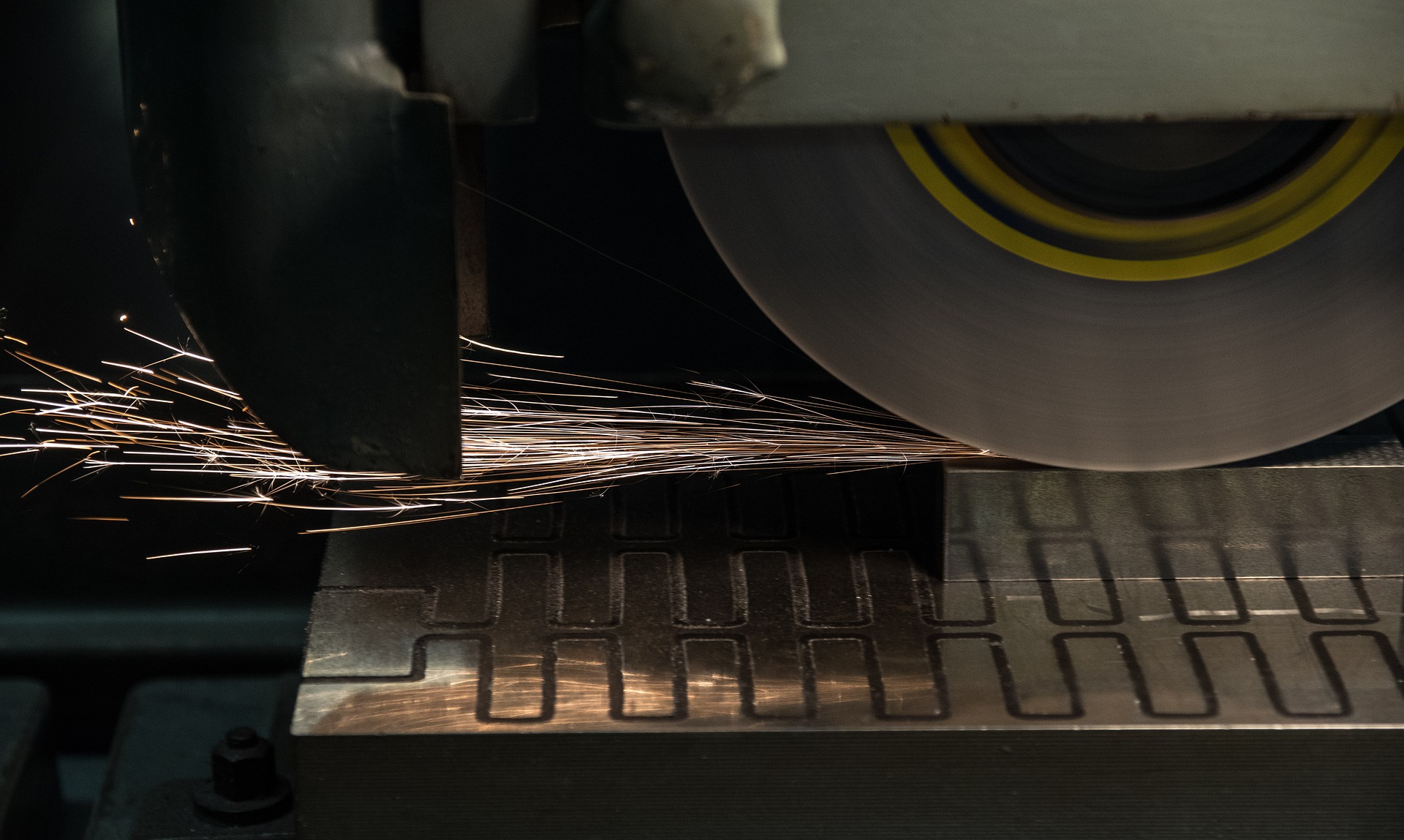
Key Points of Grinding Machine
・ Grinding machines are machine tools that use grinding wheels for machining.
・ Grinding machines are often used as a finishing process.
・ Cylindrical- and surface grinders have the majority of the market.
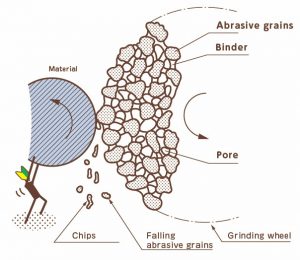 A grinding machine is a machine that precisely processes a workpiece by pressing a grinding wheel made of hardened abrasive grains against the workpiece while rotating it. Grinding is the process of machining a workpiece using a grinding wheel, and grinding machines are mainly used as a finishing process.
A grinding machine is a machine that precisely processes a workpiece by pressing a grinding wheel made of hardened abrasive grains against the workpiece while rotating it. Grinding is the process of machining a workpiece using a grinding wheel, and grinding machines are mainly used as a finishing process.
Grinding machines are used to finish workpieces that have been cut on NC lathes or machining centers (MC) to an even higher precise accuracy. For this reason, they require a higher level of machining accuracy than cutting-type machine tools.
Grinding machines are also utilized to process hardened steel and other hard materials, as well as hard and brittle materials such as glass and ceramics. These materials are difficult to machine with ordinary cutting tools.
During the grinding process, the grinding wheel wears and loses its sharpness. Therefore, grinding machine users need to regularly perform dressing and truing to regain the sharpness of the grinding wheel.
There are many types of grinding machines appropriate for the shape of the workpiece to be machined and the method of machining. Representative models include external cylindrical grinding machines, internal cylindrical grinding machines and surface grinding machines.
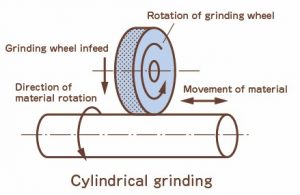 External cylindrical grinding machines apply a rotating grinding wheel to a rotating cylindrical workpiece and grind the periphery of the workpiece. This type of grinding machines is similar to lathes in that it works on a rotating workpiece, but in cylindrical grinders, the tool, the grinding wheel, rotates as well.
External cylindrical grinding machines apply a rotating grinding wheel to a rotating cylindrical workpiece and grind the periphery of the workpiece. This type of grinding machines is similar to lathes in that it works on a rotating workpiece, but in cylindrical grinders, the tool, the grinding wheel, rotates as well.
The grinding machine consists of a headstock to mount the workpiece, wheel spindle stock to mount the grinding wheel, carriage, bed, and table.
Grinding methods include 1) plunge, 2) traverse, and 3) taper grinding. Plunge grinding is a process in which the grinding wheel cuts perpendicularly into the workpiece. Traverse grinding is a method in which the workpiece or grinding wheel is moved back and forth from side to side. Taper grinding is a process in which the swiveling table is tilted to finish tapered portions.
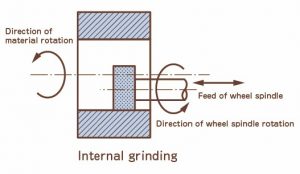 Internal cylindrical grinding machines specialize in finishing the internal surface of holes and bores. Both the cylindrical workpiece and the grinding wheel rotate, and the grinding wheel moves to cut into the workpiece to machine the internal surface of the hole. This type of grinders can machine not only the internal surface of the workpiece, but also the end faces.
Internal cylindrical grinding machines specialize in finishing the internal surface of holes and bores. Both the cylindrical workpiece and the grinding wheel rotate, and the grinding wheel moves to cut into the workpiece to machine the internal surface of the hole. This type of grinders can machine not only the internal surface of the workpiece, but also the end faces.
Internal grinding machines mainly consist of a headstock, wheel spindle stock, carriage, and bed and are similar in basic structure to external cylindrical grinding machines.
Centerless grinding machines grind the periphery of cylindrical workpieces by supporting the workpiece at three points: the grinding wheel, the regulating wheel, and the work rest. External cylindrical grinding machines, like lathes, use a chuck, center, or other holding device to secure the workpiece. In contrast, centerless grinding machines do not require a chuck or center and do not require a center hole, hence the name “centerless”. This type of grinding machine is powerful for mass-production machining of long, narrow workpieces.
They basically consist of a wheel spindle stock, a regulating wheel stock, a work rest and a bed.
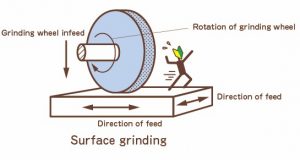 Surface grinding machines are implemented to grind the flat surface of workpieces, utilized to finishing plate or block-shaped workpieces to high precise accuracy. This type of grinders is widely used in the mold and die industry because it excels at machining metal plates.
Surface grinding machines are implemented to grind the flat surface of workpieces, utilized to finishing plate or block-shaped workpieces to high precise accuracy. This type of grinders is widely used in the mold and die industry because it excels at machining metal plates.
They basically consist of a grinding wheel head, grinding wheel spindle, table on which the workpiece is mounted, saddle, bed, and column.
Profile grinding machines are machines that use a thin, pointed grinding wheel to create the desired shape while machining the contour of the workpiece. The grinding wheel is a super abrasive wheel made of diamond or cubic boron nitride (CBN).
The operator displays the desired contour shape and the shape of the workpiece being machined on a single projector and checks to make sure that the two overlap while machining. This machining method is also called “copying” because the contour is traced.
Tool grinding machines grind a variety of cutting tools and are implemented for tool manufacturing and regrinding used tools. Target cutting tools include drills, end mills, reamers, and insert tips. These cutting tools often have more complex shapes than the workpieces targeted by general grinding. Tool grinding machines therefore require multi-axis control, such as 5-axis or 6-axis control.
Gear grinding machines are utilized to grind gear tooth grooves. Thread grinding machines are used to grind various thread products, such as ball screws used to drive machine tools. Jig grinding machines grind the inner surfaces of holes in work holding aids called jigs and measuring instruments called gauges.
Grinding centers are MC-based multitasking machines that combine both grinding and cutting in a single machine. Grinding centers have an automatic tool changer (ATC) and can be equipped with multiple axial grinding wheels. In addition to milling, drilling, and other cutting operations, this multitasking machine can also perform grinding operations using axial grinding wheels.
TAIYO KOKI releases cylindrical grinder for mass-production
Amada Machinery to release digital profile grinder
Seiko Instruments launches internal grinding machine with improved workability
Okamoto adds 3 models double column type surface grinding machine
Toyo Advanced Technologies develops vertical grinding machine suitable for medium and large bearings
Gear grinding machine faster and more accurate by reviewing the structure
March 24, 2022
March 30, 2022
March 31, 2022